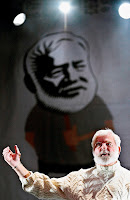The nightmare goes on. The Spanish Audiencia Nacional has decided to go ahead with the process open against the Basque newspaper "Euskaldunon Egunkaria", despite the request to drop the case by the defendants' defense team and the district attorney's office. As a direct result from this decision, five Basque citizens with professional ties to the Euskara printed newspaper that was shot down on orders by Spanish judge Juan del Olmo will now be forced to seat at the bench, accused of "integration" to ETA. They will have to face the indictments made by the extreme-right groups called Dignidad y Justica and Asociación de Víctimas del Terrorismo, both groups are resorting to a civil lawsuit, since the district attorney will not present any federal charges. The district attorney's office is not pressing any charges due to a powerful reason, after seven years of police investigation and the exhaustive analysis of thousands of documents no one has been able to find one single piece of evidence to sustain the slightest connection between ETA and the newspaper.
Powerful but insufficient reason obviously, given the decision by the judges, for this exception tribunal to declare desert a case that should have never been opened in the first place. A case that started covered by the cloak of secrecy in an obscure Guardia Civil office, that developed as a result of the internal disputes within the Audiencia Nacional, that flourished in full force with the arbitrary and traumatic clamp down on Egunkaria, and that, despite being destined to succumb due to the lack of solid evidence is being kept alive due exclusively to the dark political impulse that moves the Spanish justice system when it comes to the Basque Country.
And when it comes to the Basque Country, there is no boundaries for the Spanish democracy, that even in the XXI century allows itself to shut down Basque media outlets over one single justification: suspicion. They did it with Egin, and satisfied about the result, they did it again with Egunkaria. ¿Solid evidence?¿No room for reasonable doubt? tiny technicalities with no consequence, easily disregarded by the importance of the mission: to silence the dissidence, gag those who dare to expose and denounce the official discourse. And next to the forced silence, the chosen silence, the option by the majority of the media outlets (both Basque and Spanish) that prefer to bow before the official discourse and hide so much injustice from the public.
Powerful but insufficient reason obviously, given the decision by the judges, for this exception tribunal to declare desert a case that should have never been opened in the first place. A case that started covered by the cloak of secrecy in an obscure Guardia Civil office, that developed as a result of the internal disputes within the Audiencia Nacional, that flourished in full force with the arbitrary and traumatic clamp down on Egunkaria, and that, despite being destined to succumb due to the lack of solid evidence is being kept alive due exclusively to the dark political impulse that moves the Spanish justice system when it comes to the Basque Country.
And when it comes to the Basque Country, there is no boundaries for the Spanish democracy, that even in the XXI century allows itself to shut down Basque media outlets over one single justification: suspicion. They did it with Egin, and satisfied about the result, they did it again with Egunkaria. ¿Solid evidence?¿No room for reasonable doubt? tiny technicalities with no consequence, easily disregarded by the importance of the mission: to silence the dissidence, gag those who dare to expose and denounce the official discourse. And next to the forced silence, the chosen silence, the option by the majority of the media outlets (both Basque and Spanish) that prefer to bow before the official discourse and hide so much injustice from the public.
.... ... .













